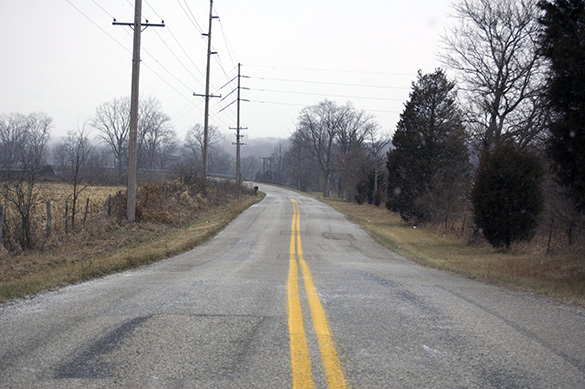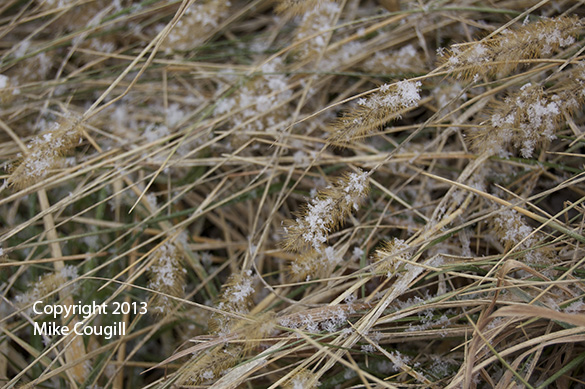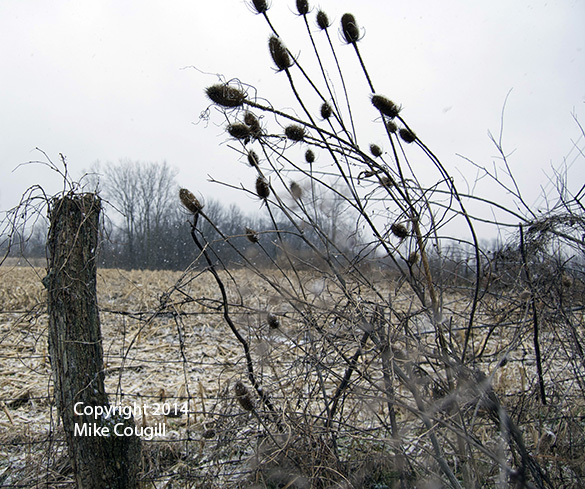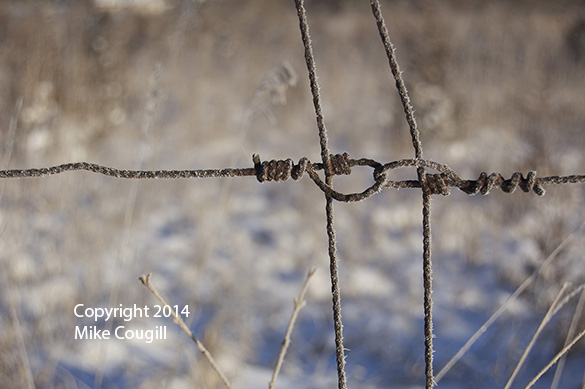An unspoken drawback to turning your hobby into full-time work is that there is no escape from it. There are two different mindsets between the enjoyment of a recreational pastime and earning a living from something. Blending the two can be done but it takes a degree of mental discipline to maintain a good balance.
It’s a discipline I’m still learning and doing a poor job with. Experience has taught me that I need a creative outlet to enjoy just for the fun of it. Time at the modeling bench used to fill this need but I now find myself thinking I should be photographing the construction process of whatever I’m working on for future use in TMC or some other book project.
Feeling in a rut over the holidays, I wanted a project that I could practice on a regular basis and with a minimum of prep time. I live in a rural area and our house is separated from the neighbors on one side by a seven acre meadow, that creates a distance of a hundred yards or more between our drive and the next. For a creative challenge, I decided to explore this short stretch of road as a refresher course in learning to see as an artist. So, every morning for a week I took a short walk, camera in tow, to see what I could find in terms of subject matter.
The road doesn’t offer anything of visual interest at first glance and most would consider it totally barren of anything photogenic. The first morning went as expected, meaning I purposely got the typical snapshot views out of my system (above). I didn’t have any expectations per se and if nothing caught my eye, that would have been fine. At least I would enjoy a pleasant walk.
It didn’t take long before I began to find the patterns and texture of the frost killed grasses along the edge of the road quite interesting. They’re a tangled abstraction of lines and odd shapes contrasted by clusters of the grass seed heads that to my eye, resembled schools of little fish. A light dusting of snow the next morning gave the seed heads a completely different look.
Another subject that caught my interest was the tangle of vegetation growing along the fence line of the crop field. The taller grasses and other shrubs created lots of different compositions against the horizontal nature of the landscape and the weathered range fencing became a subject in itself. Overnight snows on days three, four and five added another visual dimension.
I shot 172 images during the week and whittled them down to ten that I compiled into a simple PDF monograph with titles and a short text, that I could easily share with family and friends. It proved to be a fun exercise and it felt good to flex the creative visual muscles. A week is hardly enough time to provide a thorough understanding of a subject, so I plan to continue the exploration to deepen my understanding and also, to increase my visual vocabulary. The deliberate limitations I chose for the project served well as guides.
This has everything to do with railroad modeling
To professional creatives, limitations are an opportunity to really flex the imagination. I imagine any architect will say the project with the most restrictive site conditions invariably produces the most satisfying building design.
Hobbyists by contrast view any limitation as an enemy that wants to rob us of all our fun. If people can’t have that gigantic dream space, then too many simply give up or settle for some poorly designed throw-away layout. A “tiny” 10’x10′ spare room is seen as a horrible, restrictive strait-jacket rather than the opportunity to really focus and do something unique. It’s only when we can let go of all those preconceived notions of what makes a satisfying layout, are we able to consider ideas that might lead to a better solution.
The notion of unlimited creative freedom is a pernicious myth. In the real world, without guidelines or a structure of some kind, creativity flounders. The narrow parameters I imposed on my photography exercise forced me to look at my chosen subject more deeply. They forced me to go beyond surface prettiness and find the hidden-in-plain sight subjects right in front of my eyes.
In the same way, having a structure that forces one to focus on ideas instead of obsessing over how much stuff can I have, is more likely to produce a satisfying layout design solution regardless of the available space one has to work with.
Have we sacrificed genuine creative thinking about what a layout is or could be on the model-railroad-as-stuff altar? Sadly, yes and I’m not certain we’ve improved our lot as a result. On that note, I feel the urge to grab my camera and take a walk up the road. Umm, maybe I’ll wait until the wind chill temps climb above zero again.
Regards,
Mike




Mike,
I could not agree with you more on all points. Excellent post. I am guilty as charged. In my case, too many varied interests in real life railroading that keep me from focusing on the actual building of a model railroad. Thank you for pointing out the most obvious problem…unlimited creative freedom!
“The notion of unlimited creative freedom is a pernicious myth. In the real world, without guidelines or a structure of some kind, creativity flounders. The narrow parameters I imposed on my photography exercise forced me to look at my chosen subject more deeply. They forced me to go beyond surface prettiness and find the hidden-in-plain sight subjects right in front of my eyes.”
It is time to place some parameters on my modeling!
Matt
Hi Matt,
When I still lived at my parents house, I had a 7′ x 13′ spare room to use. Of several layouts I built in there, the most complete and satisfying was a simple quarter-inch scale switching layout.
It had hand laid track and just three turnouts. It was the only layout in that room that reached the finished scenery and operational stages. I knew nothing of layout design back then. I just did what I could with the space available.
If that’s all the space I had today, I would do something similar. The key is to accept any so-called limitations, work with them, forget what a layout is supposed to be and let your imagination work on what a layout could be.
Regards,
Mike
Look at the road in that first picture. Look at the colours, look at the texture, look at the camber, look at the grassy edges look at how far it is from flat and level. Most of all, did you notice the outline of a patch-repair at some point?
There is a well-known phrase, “as dull as ditchwater”. To a microbiologist, ditchwater is anything but dull.
As I have said before, available space is not a constraint, but a parameter. The aim is to find. The best possible use of it that aligns with one’s own interests and preferences, and it may be that type of layout is a stronger preference than scale of models.
In Narrow Gauge Railway Modelling, the late Donald Boreham commented that “perhaps the best scale to model in, is the largest one that can be accommodated”. On the face of it, this is a suggestion to model in G scale wherever possible, but he was cleverer than that, much much cleverer. The model in question was of a single steam engine, and was very impressive. It was not a model of a station, or a layout. In the same available space, the “largest scale” would be smaller. For example, if operating trains on a layout is your thing, but your available space is a box room, then N gauge is worth considering. However, someone with an interest in rural shortlining, and prepared to accept 18″ curves, might be inspired to follow my friend Steve Flanigan’s example and work in H0. Someone more interested in building models of engines may turn a large part of the space over to machine tools and a modelling bench, with possible a small loco depot or switching layout on which to display and occasionally run their completed models
Not everyone has a house with a garage, but if they do, then something inspired by Mike Confalone’s former “Hardwick and Woodbury Division of the Woodsville Terminal” (MRP 2007), now revised as Andover, Me on the Allagash Railroad, can be built don one side of the garage, on shelf brackets arranged to be above the car when it is inside.
And so on: nothing but a small cupboard? Acquire a few hand tools and get some equipment built/modified/detailed/painted. “Givens” means, things you have, not things ou don’t have – hence he word: things which are already there, what you have been able to give to your hobby out of life’s resources.
Keep up the good work!
Simon
Hi Simon,
Good points as always.
I feel that with all the emphasis on presenting the hobby as “stuff” and technique, we’ve lost something fundamental to it. That being what the person brings of themselves to the activity. I touched on this a few weeks ago with the post about how your layout doesn’t lie.
I coming to the thought that if one wants to truly understand a person’s work -creative or otherwise- one has to better understand the person first. What is their viewpoint, how do they approach life, how do they execute a task? All of these qualities are present in their work when one knows what to look for.
If this craft is nothing more than an excuse to buy things or develop some slick technique, then it’s a moot point. What if however, there is more to it than that? As a means of creative expression, this craft has all the characteristics and potential of any other art form (in my view at least). If that’s so, then it can embrace larger questions than we typically bring to it.
I’m convinced the thinking within the hobby has grown shallow. That people no longer bring much of their imagination to bear because it’s easier to just wait until a magazine article or online forum tells you what to do. It’s truly sad and this is why I harp on the subject so much.
Regards,
Mike
Interesting response, Mike: even more thought provoking than usual.
I agree with you that the craft is more than technique or buying things. I know some very fine modellers, and most of them produce layouts which have that something extra. One or two produce museum quality models, but their very perfect ion is. I think, their downfall. Real things have rough edges, they have “the edges knocked off them”. These are small, and probably disappear as they are scaled down, but they add a little warmth to the subject. When building a model this comes across as knowing when to stop filing: maybe 89.9 degrees on an edge is enough?
And to link back to last week, the sterility tends to appear where the model is an attempt to directly imitate the prototype, rather than, shall we say, “distill the essence”. As with filing, though, it is knowing when to stop: it is possible to “over-extract” the key features, and end up with nothing more than a caricature.
What is the solution to this? I can think of only one way of putting it, which is “love of subject”. We see this in great works of art. I am not anywhere as interested in art as toy trains, but I understand that many great artist had an ongoing passionate affair with his model/muse, and his love came through in the work.
Maybe these are just the ramblings of a deranged, opinionated, self-appointed expert (some of which I have been called this past week, and the remainder at other times), but they are where your provocations take me this time!
Simon
Just in case anyone is bemused by this:
I was referring to an amusing exchange where I had taken the trouble to find out about what I was talking about, but accused of being a self-appointed expert as a consequence. (Presumably it’s ok to be an ignoramus.) I have opinions, which makes some see me as opinionated (if I have nothing to say, I do say it) and deranged is, fom my point of view, a compliment. I mean, who wants to be dull and unoriginal? Ramblings: my description for anything on a blog.
Provocations? Well, Mike provokes thoughts…
Simon